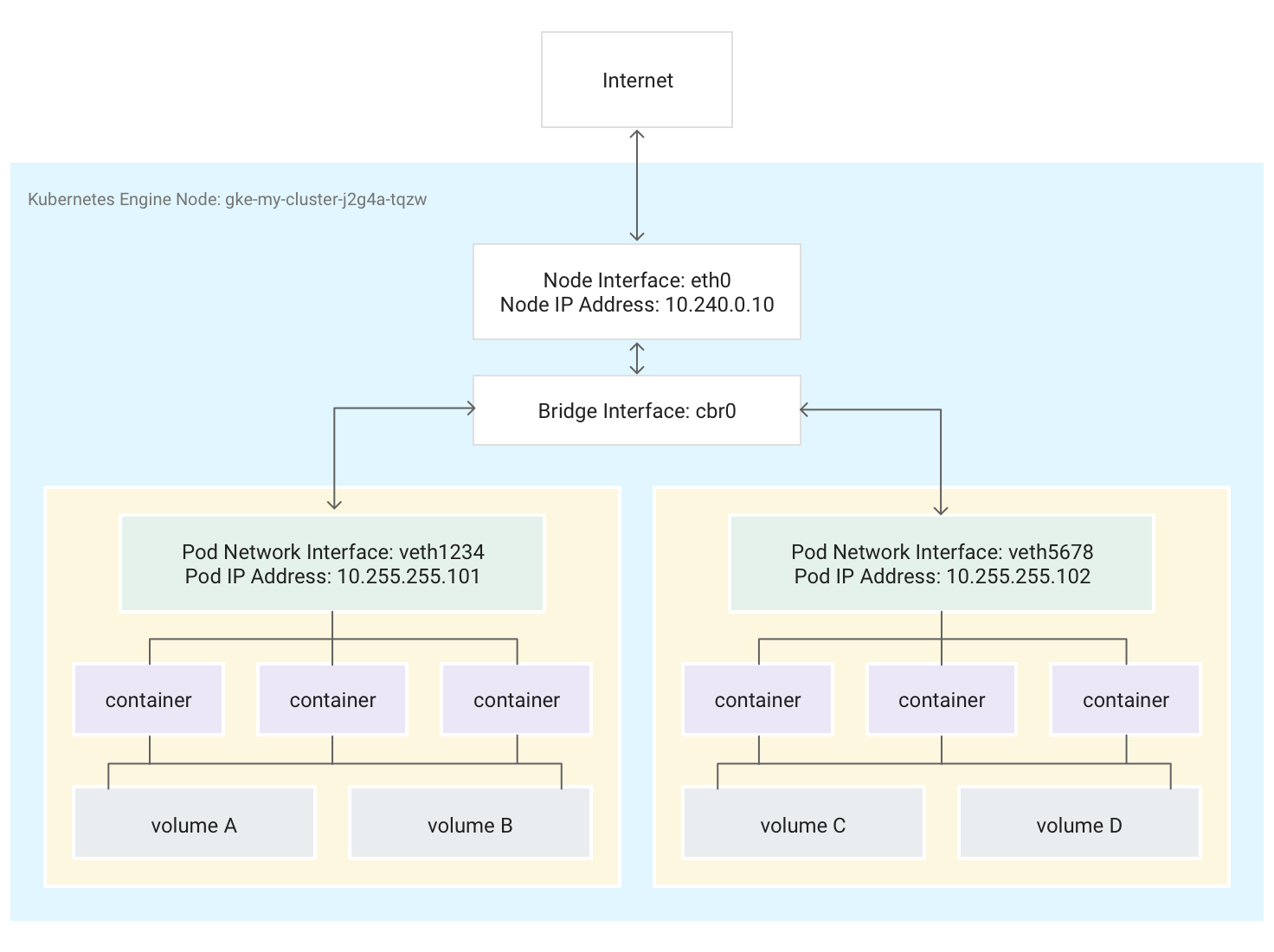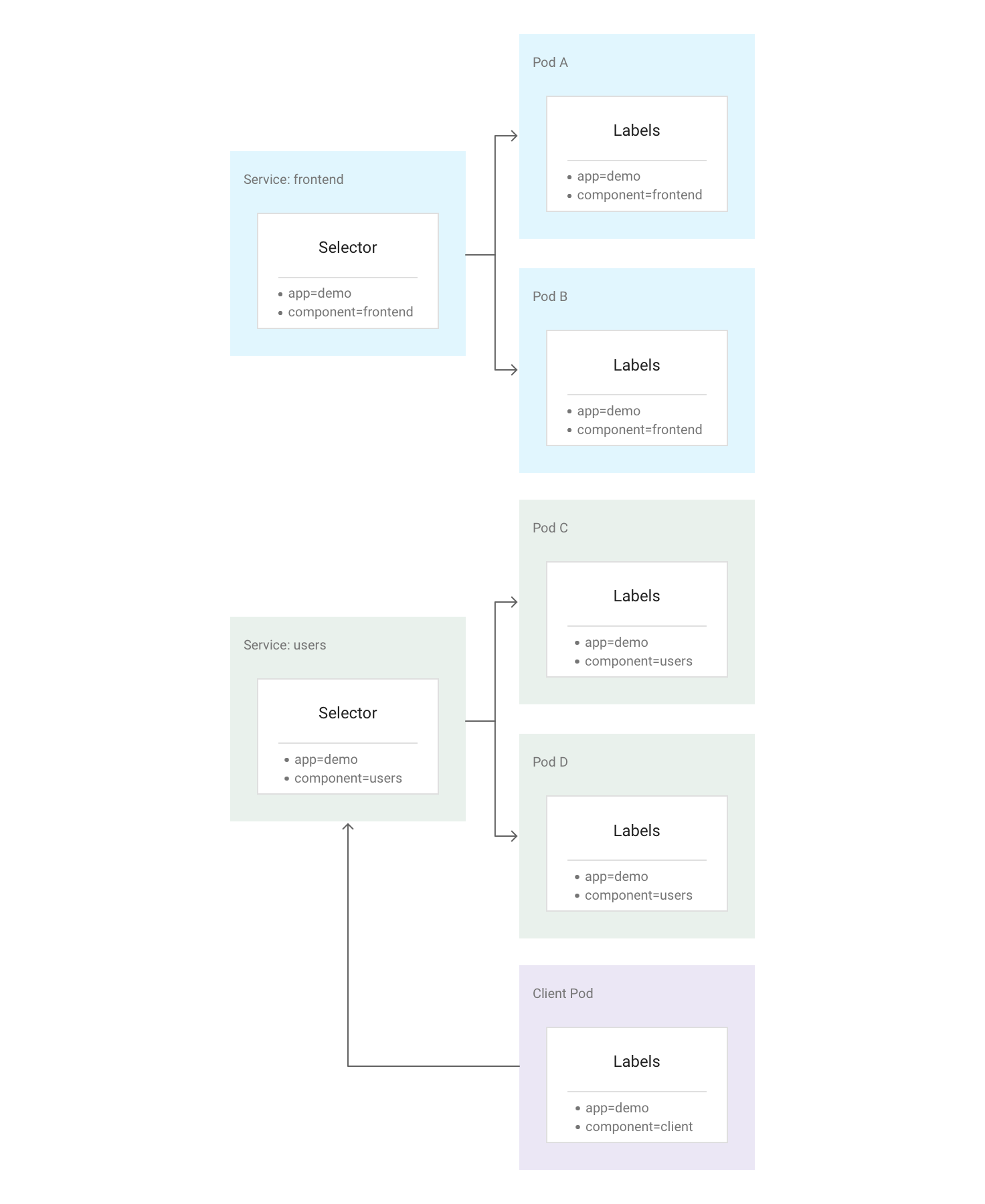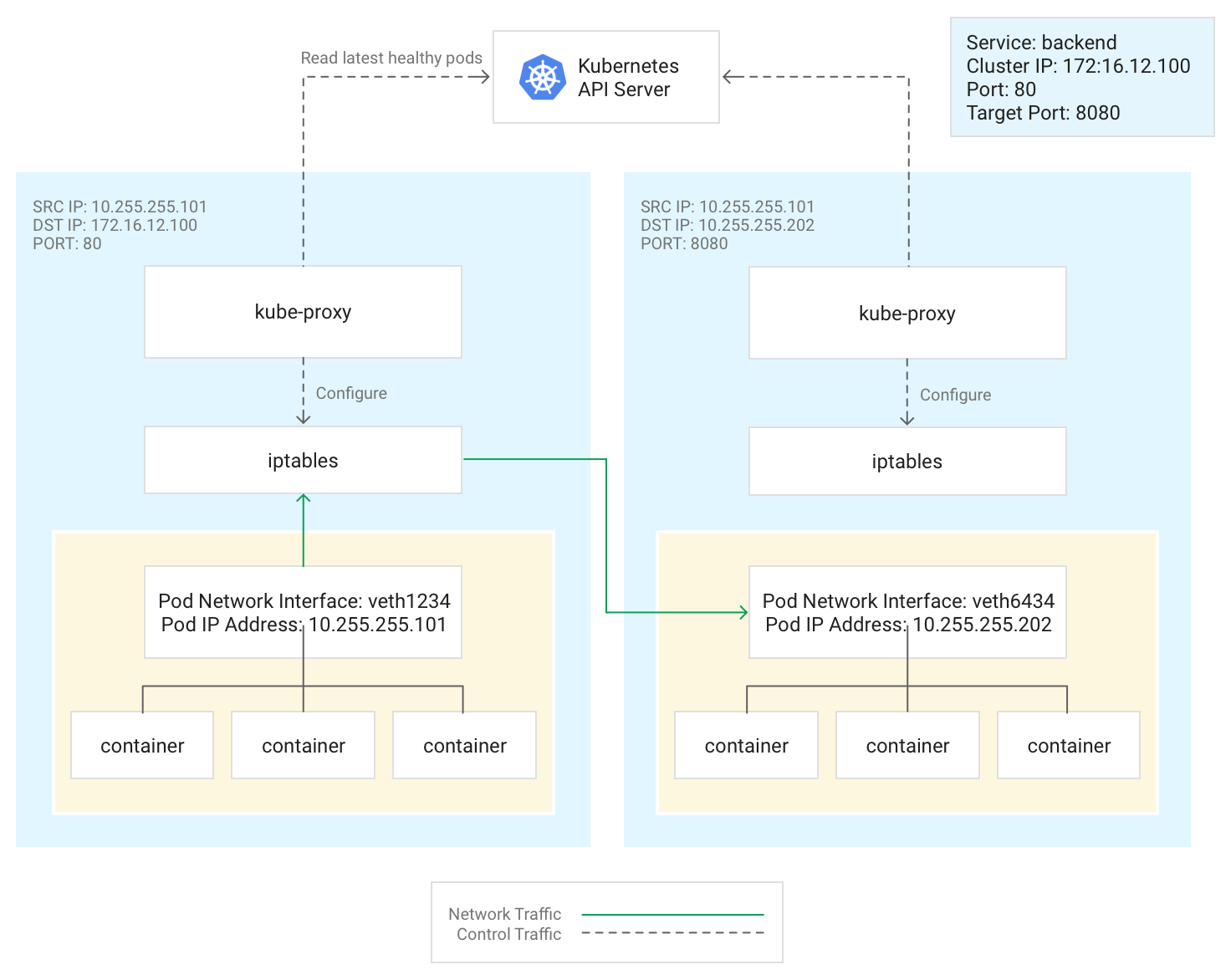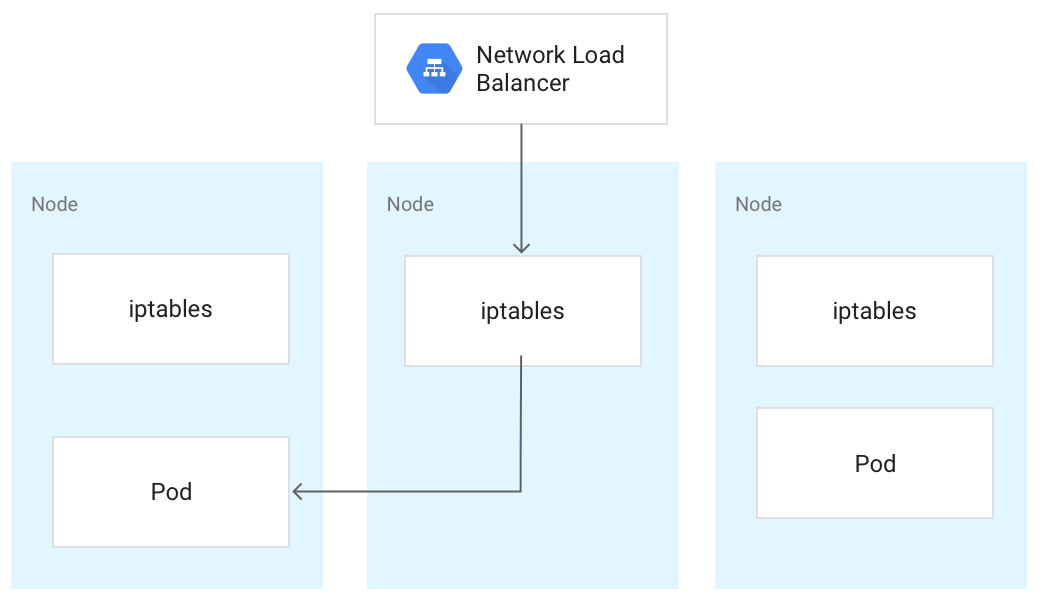This page provides a guide to the main aspects of Google Kubernetes Engine (GKE) networking.
This page doesn't cover general Kubernetes or GKE topics. This page assumes that you know about the following:
- Linux network management concepts
- Utilities, such as routing and
iptablesrules
In addition, this page assumes that you know basic terminology that relate to the following:
- Transport layer
- Internet layer
- Application layers
- Internet protocol (IP) suite, including HTTP and DNS
This page and the rest of this documentation set are for Cloud architects and Networking specialists who design and architect the network for their organization. For an overview of all GKE documentation sets, see Explore GKE documentation. To learn more about common roles and example tasks that we reference in Google Cloud content, see Common GKE user roles and tasks.
Kubernetes lets you declaratively define how your applications are deployed, how applications communicate with each other and with the Kubernetes control plane, and how clients can reach your applications. This page also provides information about how GKE configures Google Cloud services, where it is relevant to networking.
Why Kubernetes networking is different
When you use Kubernetes to orchestrate your applications, it's important to change how you think about the network design of your applications and their hosts. With Kubernetes, you think about how Pods, Services, and external clients communicate, rather than thinking about how your hosts or virtual machines (VMs) are connected.
Kubernetes' advanced software-defined networking (SDN) enables packet routing and forwarding for Pods, Services, and nodes across different zones in the same regional cluster. Kubernetes and Google Cloud also dynamically configure IP filtering rules, routing tables, and firewall rules on each node, depending on the declarative model of your Kubernetes deployments and your cluster configuration on Google Cloud.
Terminology related to Kubernetes networking
The Kubernetes networking model relies heavily on IP addresses. Services, Pods, containers, and nodes communicate using IP addresses and ports. Kubernetes provides different types of load balancing to direct traffic to the correct Pods. All of these mechanisms are described in more detail later. Keep the following terms related to IP addresses in mind as you read:
- ClusterIP: The IP address assigned to a Service. In other documents, it might be called the "Cluster IP". This address is stable for the lifetime of the Service, as discussed in Services.
- Pod IP address: The IP address assigned to a given Pod. This is ephemeral, as discussed in Pods.
- Node IP address: The IP address assigned to a given node.
Cluster connectivity requirements
All clusters require connectivity to *.googleapis.com, *.gcr.io,
*.pkg.dev, and the control plane IP address. This requirement is satisfied by
the implied allow egress rules and
the automatically created firewall
rules that GKE
creates.
Networking inside the cluster
This section discusses networking within a Kubernetes cluster, as it relates to IP allocation, Pods, Services, DNS, and the control plane.
IP address allocation
Kubernetes uses various IP ranges to assign IP addresses to nodes, Pods, and Services.
- Each node has an IP address assigned from the cluster's
Virtual Private Cloud (VPC) network. This node IP provides connectivity from
control components like
kube-proxyand thekubeletto the Kubernetes API server. This IP address is the node's connection to the rest of the cluster. Each node has a pool of IP addresses that GKE assigns Pods running on that node (a /24 CIDR block by default). You can optionally specify the range of IPs when you create the cluster. The Flexible Pod CIDR range feature lets you reduce the size of the range for Pod IP addresses for nodes in a node pool
Each Pod has a single IP address assigned from the Pod CIDR range of its node. This IP address is shared by all containers running within the Pod, and connects them to other Pods running in the cluster.
Each Service has an IP address, called the ClusterIP, assigned from the cluster's VPC network. You can optionally customize the VPC network when you create the cluster.
Each control plane has a public or internal IP address based on the type of cluster, version, and creation date. For more information, see control plane description.
GKE networking model doesn't allow IP addresses to be reused across the network. When you migrate to GKE, you must plan your IP address allocation to Reduce internal IP address usage in GKE.
Maximum transmission unit (MTU)
The MTU selected for a Pod interface is dependent on the Container Network Interface (CNI) used by the cluster Nodes and the underlying VPC MTU setting. For more information, see Pods.
The Pod interface MTU value is either 1460 or inherited from the primary
interface of the Node.
| CNI | MTU | GKE Standard |
|---|---|---|
| kubenet | 1460 | Default |
|
kubenet (GKE version 1.26.1 and later) |
Inherited | Default |
| Calico | 1460 |
Enabled by using For details, see Control communication between Pods and Services using network policies. |
| netd | Inherited | Enabled by using any of the following: |
| GKE Dataplane V2 | Inherited |
Enabled by using For details, see Using GKE Dataplane V2. |
For more information, see VPC-native clusters.
Supported network plugins
- To use a network plugin, you must install it yourself. GKE offers the following natively supported network plugins:
- Calico (in Dataplane V1)
- Cilium (in Dataplane V2)
- Istio-CNI (in the Managed Dataplane Controller for GKE Enterprise)
Pods
In Kubernetes, a Pod is the most basic deployable unit within a Kubernetes cluster. A Pod runs one or more containers. Zero or more Pods run on a node. Each node in the cluster is part of a node pool.
In GKE, these nodes are virtual machines, each running as an instance in Compute Engine.
Pods can also attach to external storage volumes and other custom resources. This diagram shows a single node running two Pods, each attached to two volumes.

When Kubernetes schedules a Pod to run on a node, it creates a
network namespace
for the Pod in the node's Linux kernel. This network namespace connects the
node's physical network interface, such as eth0, with the Pod using a virtual
network interface, so that packets can flow to and from the Pod. The associated
virtual network interface in the node's root network namespace connects to a
Linux bridge that allows communication among Pods on the same node. A Pod can
also send packets outside of the node using the same virtual interface.
Kubernetes assigns an IP address (the Pod IP address) to the virtual network interface in the Pod's network namespace from a range of addresses reserved for Pods on the node. This address range is a subset of the IP address range assigned to the cluster for Pods, which you can configure when you create a cluster.
A container running in a Pod uses the Pod's network namespace. From the
container's point of view, the Pod appears to be a physical machine with one
network interface. All containers in the Pod see this same network interface.
Each container's localhost is connected, through the Pod, to the node's
physical network interface, such as eth0.
Note that this connectivity differs drastically depending on whether you use GKE's Container Network Interface (CNI) or choose to use Calico's implementation by enabling Network policy when you create the cluster.
If you use GKE's CNI, one end of the Virtual Ethernet Device (veth) pair is attached to the Pod in its namespace, and the other is connected to the Linux bridge device
cbr0.1 In this case, the following command shows the various Pods' MAC addresses attached tocbr0:arp -nRunning the following command in the toolbox container shows the root namespace end of each veth pair attached to
cbr0:brctl show cbr0If Network Policy is enabled, one end of the veth pair is attached to the Pod and the other to
eth0. In this case, the following command shows the various Pods' MAC addresses attached to different veth devices:arp -nRunning the following command in the toolbox container shows that there is not a Linux bridge device named
cbr0:brctl show
The iptables rules that facilitate forwarding within the cluster differ from one scenario to the other. It is important to have this distinction in mind during detailed troubleshooting of connectivity issues.
By default, each Pod has unfiltered access to all the other Pods running on all nodes of the cluster, but you can limit access among Pods. Kubernetes regularly tears down and recreates Pods. This happens when a node pool is upgraded, when changing the Pod's declarative configuration or changing a container's image, or when a node becomes unavailable. Therefore, a Pod's IP address is an implementation detail, and you shouldn't rely on them. Kubernetes provides stable IP addresses using Services.
-
The virtual network bridge
cbr0is only created if there are Pods which sethostNetwork: false.↩
Services
In Kubernetes, you can assign arbitrary key-value pairs called labels to any Kubernetes resource. Kubernetes uses labels to group multiple related Pods into a logical unit called a Service. A Service has a stable IP address and ports, and provides load balancing among the set of Pods whose labels match all the labels you define in the label selector when you create the Service.
The following diagram shows two separate Services, each of which is comprised of
multiple Pods. Each of the Pods in the diagram has the label app=demo, but
their other labels differ. Service "frontend" matches all Pods with both
app=demo and component=frontend, while Service "users" matches all Pods with
app=demo and component=users. The Client Pod does not match either Service
selector exactly, so it is not a part of either Service. However, the Client Pod
can communicate with either of the Services because it runs in the same cluster.

Kubernetes assigns a stable, reliable IP address to each newly-created Service (the ClusterIP) from the cluster's pool of available Service IP addresses. Kubernetes also assigns a hostname to the ClusterIP, by adding a DNS entry. The ClusterIP and hostname are unique within the cluster and don't change throughout the lifecycle of the Service. Kubernetes only releases the ClusterIP and hostname if the Service is deleted from the cluster's configuration. You can reach a healthy Pod running your application using either the ClusterIP or the hostname of the Service.
At first glance, a Service may seem to be a single point of failure for your applications. However, Kubernetes spreads traffic as evenly as possible across the full set of Pods, running on many nodes, so a cluster can withstand an outage affecting one or more (but not all) nodes.
Kube-Proxy
Kubernetes manages connectivity among Pods and Services using the kube-proxy
component, which traditionally runs as a static Pod on each node.
kube-proxy, which is not an inline proxy, but an egress-based
load-balancing controller, watches the Kubernetes API server and continually
maps the ClusterIP to healthy Pods by adding and removing destination NAT (DNAT)
rules to the node's iptables subsystem. When a container running in a Pod
sends traffic to a Service's ClusterIP, the node selects a Pod at random and
routes the traffic to that Pod.
When you configure a Service, you can optionally remap its listening port by
defining values for port and targetPort.
- The
portis where clients reach the application. - The
targetPortis the port where the application is actually listening for traffic within the Pod.
kube-proxy manages this port remapping by adding and removing iptables rules
on the node.
This diagram illustrates the flow of traffic from a client Pod to a server Pod
on a different node. The client connects to the Service at 172.16.12.100:80.
The Kubernetes API server maintains a list of Pods running the application. The
kube-proxy process on each node uses this list to create an iptables rule to
direct traffic to an appropriate Pod (such as 10.255.255.202:8080). The client
Pod does not need to be aware of the topology of the cluster or any details
about individual Pods or containers within them.

How kube-proxy is deployed depends on the GKE version of the
cluster:
- For GKE versions 1.16.0 and 1.16.8-gke.13,
kube-proxyis deployed as a DaemonSet. - For GKE versions later than 1.16.8-gke.13,
kube-proxyis deployed as a static Pod for nodes.
DNS
GKE provides the following managed cluster DNS options to resolve service names and external names:
kube-dns: a cluster add-on that is deployed by default in all GKE clusters. For more information, see Using kube-dns.
Cloud DNS: a cloud-managed cluster DNS infrastructure that replaces kube-dns in the cluster. For more information, see Use Cloud DNS for GKE.
GKE also provides NodeLocal DNSCache as an optional add-on with kube-dns or Cloud DNS to improve cluster DNS performance.
To learn more about how GKE provides DNS, see Service discovery and DNS.
Control plane
In Kubernetes, the control plane manages the control plane processes, including the Kubernetes API server. How you access the control plane depends on how you've configured the control plane network isolation.
Networking outside the cluster
This section explains how traffic from outside the cluster reaches applications running within a Kubernetes cluster. This information is important when designing your cluster's applications and workloads.
You've already read about how Kubernetes uses Services to provide
stable IP addresses for applications running within Pods. By default,
Pods don't expose an external IP address, because kube-proxy manages all
traffic on each node. Pods and their containers can
communicate freely, but connections outside the cluster cannot access the
Service. For example, in the previous illustration, clients outside the cluster
cannot access the frontend Service using its ClusterIP.
GKE provides three different types of load balancers to control access and to spread incoming traffic across your cluster as evenly as possible. You can configure one Service to use multiple types of load balancers simultaneously.
- External load balancers manage traffic coming from outside the cluster and outside your Google Cloud VPC network. They use forwarding rules associated with the Google Cloud network to route traffic to a Kubernetes node.
- Internal load balancers manage traffic coming from within the same VPC network. Like external load balancers, they use forwarding rules associated with the Google Cloud network to route traffic to a Kubernetes node.
- Application Load Balancers are specialized external load balancers used for HTTP(S) traffic. They use a Gateway (recommended) or Ingress resource rather than a forwarding rule to route traffic to a Kubernetes node.
When traffic reaches a Kubernetes node, it is handled the same way, regardless
of the type of load balancer. The load balancer is not aware of which nodes
in the cluster are running Pods for its Service. Instead, it balances traffic
across all nodes in the cluster, even those not running a relevant Pod. On a
regional cluster, the load is spread across all nodes in all zones for the
cluster's region. When traffic is routed to a node, the node routes the traffic
to a Pod, which may be running on the same node or a different node. The node
forwards the traffic to a randomly chosen Pod by using the iptables rules
that kube-proxy manages on the node.
In the following diagram, the external passthrough Network Load Balancer directs traffic to the middle node, and the traffic is redirected to a Pod on the first node.

When a load balancer sends traffic to a node, the traffic might get forwarded to a Pod on a different node. This requires extra network hops. If you want to avoid the extra hops, you can specify that traffic must go to a Pod that is on the same node that initially receives the traffic.
To specify that traffic must go to a Pod on the same node, set
externalTrafficPolicy to Local in your Service manifest:
apiVersion: v1
kind: Service
metadata:
name: my-lb-service
spec:
type: LoadBalancer
externalTrafficPolicy: Local
selector:
app: demo
component: users
ports:
- protocol: TCP
port: 80
targetPort: 8080
When you set externalTrafficPolicy to Local, the load balancer sends
traffic only to nodes that have a healthy Pod that belongs to the Service.
The load balancer uses a health check to determine which nodes have the
appropriate Pods.
External load balancer
If your Service needs to be reachable from outside the cluster and outside your
VPC network, you can configure your Service as a
LoadBalancer,
by setting the Service's type field to Loadbalancer when defining the
Service. GKE then provisions an
external passthrough Network Load Balancer in front of the Service.
The external passthrough Network Load Balancer is aware of all nodes in your cluster and configures
your VPC network's firewall rules to allow connections to the
Service from outside the VPC network, using the Service's
external IP address. You can assign a static external IP address to the Service.
For more information, see Configuring domain names with static IP addresses.
To learn more about firewall rules, see Automatically created firewall rules.
Technical details
When using the external load balancer, arriving traffic is initially routed to
a node using a forwarding rule associated with the Google Cloud network.
After the traffic reaches the node, the node uses its iptables NAT table to
choose a Pod. kube-proxy manages the iptables rules on the node.
Internal load balancer
For traffic that needs to reach your cluster from within the cluster's VPC network or from networks that are connected to the cluster's VPC network, you can configure your Service to provision an internal passthrough Network Load Balancer. The internal passthrough Network Load Balancer chooses an IP address from your cluster's VPC subnet instead of an external IP address. Applications or services, whether they're within the cluster's VPC network or in connected networks, can use this IP address to communicate with Services inside the cluster.
Technical details
Internal load balancing is provided by Google Cloud. When
the traffic reaches a given node, that node uses its iptables NAT table to
choose a Pod, even if the Pod is on a different node.
kube-proxy manages the iptables rules on the node.
For more information about internal load balancers, see Using an internal passthrough Network Load Balancer.
Application Load Balancer
Many applications, such as RESTful web service APIs, communicate using HTTP(S). You can allow clients external to your VPC network to access this type of application using the Kubernetes Gateway API.
The GKE Gateway controller is Google's implementation of the Kubernetes Gateway API for Cloud Load Balancing. Gateway API is an open-source project aimed at standardizing how service meshes and ingress controllers expose applications in Kubernetes. It's designed to be a more expressive, flexible, and extensible successor to the Ingress resource.
The GKE Gateway controller is used to configure Layer 7 Application Load Balancers to expose HTTP(S) traffic to applications that run in the cluster.
Use Gateway API to implement your load balancer.
Gateway API uses the following resources:
- Gateway Class: this resource defines the type of load balancer that GKE implements. GKE provides GatewayClasses that can be used in clusters.
- Gateway: a Gateway resource defines listener configurations such as ports, protocols and hostnames, and acts as the entry point for traffic into your cluster.
- HTTPRoute: an HTTPRoute specifies how traffic received by a Gateway is routed to Services. HTTPRoutes can include advanced features like path-based routing, header matching, traffic splitting for A/B testing, and more fine-grained control over timeouts and retries.
- Policy: you can attach a policy to a Gateway, a Route, or a Kubernetes Service to define how the underlying Google Cloud infrastructure should function.
For more information, see About Gateway API.
Technical details
When you create a Gateway object, the GKE Gateway controller
configures an Application Load Balancer according to the rules
in the Gateway, HTTPRoute, and Service manifests. The client sends a
request to the Application Load Balancer. The load balancer is an actual proxy; it
chooses a node and forwards the request to that node's NodeIP:NodePort
combination. The node uses its iptables NAT table to choose a Pod.
kube-proxy manages the iptables rules on the node.
Networking security
To enhance the security of your cluster, you can limit connectivity among nodes, between Pods, and to load balancers.
Limit connectivity among nodes
Creating ingress or egress firewall rules targeting nodes in your cluster may have
adverse effects. For example, applying egress deny rules to nodes in your
cluster could break features such as NodePort and kubectl exec.
Limit connectivity to Pods and Services
By default, all Pods running within the same cluster can communicate freely. However, you can limit connectivity within a cluster in different ways, depending on your needs.
Limit access among Pods
You can limit access among Pods using a network policy. Network policy definitions allow you to restrict the ingress and egress of Pods based on an arbitrary combination of labels, IP ranges, and port numbers.
By default, there is no network policy, so all traffic among Pods in the cluster is allowed. As soon as you create the first network policy in a namespace, all other traffic is denied.
After creating a network policy, you must explicitly enable it for the cluster. For more information, see Configuring network policies for applications.
Limit access to an external load balancer
If your Service uses an external load balancer, traffic from any
external IP address can access your Service by default. You can restrict which
IP address ranges can access endpoints within your cluster, by configuring the
loadBalancerSourceRanges option when configuring the Service. You can specify
multiple ranges, and you can update the configuration of a running Service at
any time. The kube-proxy instance running on each node configures that node's
iptables rules to deny all traffic that does not match the specified
loadBalancerSourceRanges. Additionally, when you create a LoadBalancer
Service, GKE creates a corresponding VPC firewall
rule to enforce these restrictions at the network level.
Limit access to an Application Load Balancer
If your service uses an Application Load Balancer, you can use a Google Cloud Armor security policy to limit which external IP addresses can access your Service and which responses to return when access is denied because of the security policy. You can configure Cloud Logging to log information about these interactions.
If a Cloud Armor security policy is not fine-grained enough, you can enable the Identity-Aware Proxy on your endpoints to implement user-based authentication and authorization for your application. Visit the detailed tutorial for configuring IAP for more information.
Known issues
This section covers the known issues.
Container-enabled node unable to connect to 172.17/16 range
A node VM with containerd enabled cannot connect to a host that has an IP
within 172.17/16. For more information, see
Conflict with 172.17/16 IP address range.
Remaining resources from deleted GKE clusters with Private Service Connect
If you created and deleted GKE clusters with Private Service Connect before May 7, 2024, and you deleted the project containing the cluster before the cluster itself, you might have leaked associated Private Service Connect resources. These resources remain hidden and don't allow you to delete the associated subnets. If you encounter this issue, contact Google Cloud Support.
